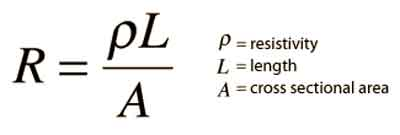Unit of Electrical Resistance - Understanding the Ohm
The unit of electrical resistance, the Ohm, is a cornerstone of the electrical world. Its importance in governing the behaviour of electric currents, designing efficient circuits, and ensuring the safe operation of devices cannot be overstated. By understanding the intricacies of resistance and Ohm's law, it is possible to harness the power of electricity to create innovative and practical solutions that benefit our daily lives.

The world of electricity is complex and fascinating, with numerous components working in unison to power our lives. One such essential element is the unit of electrical resistance, the Ohm (ω), named after Georg Simon Ohm, a German physicist. The Ohm plays a vital role in the functioning of electrical circuits and everyday devices. This article delves into the intricacies of this unit and its significance in the realm of electricity.
First and foremost, it is crucial to understand the basic concept of resistance. In simple terms, resistance is the opposition to the flow of electric current through a conductor. It is an essential factor that influences the behaviour and efficiency of electrical circuits. The Ohm (Ω) is the SI unit of electric resistance, represented by the Greek letter omega (ω). One Ohm is defined as the resistance of a conductor that allows one ampere of current to flow when one volt of potential difference is applied across it.
Ohm's law defines the relationship between resistance, voltage, and electric current, a fundamental principle in electrical engineering. The law states that the current passing through a conductor is directly proportional to the voltage applied and inversely proportional to its resistance. Mathematically, it is expressed as V = IR, where V is the voltage, I is the electric current, and R is the resistance. This equation helps in determining the resistance in various circuits and devices.
Several factors influence the resistance of a material, including its resistivity, length, cross-sectional area, and temperature. For example, materials with high resistivity, like insulators, have greater resistance than conductors, which have low resistivity. Additionally, longer conductors and those with smaller cross-sectional areas have higher resistance compared to shorter conductors and those with larger cross-sectional areas. The temperature of a material also affects its resistance, as the resistance typically increases with a temperature rise.
How do I measure a electrical resistance?
You can use a multimeter, a versatile electronic measuring instrument, to measure the resistance of a component or a circuit. A multimeter can measure various electrical parameters such as voltage, current, and resistance. Follow these steps to measure the resistance of a component or circuit:
Turn off the power: Ensure that the component or circuit is disconnected from any power source before measuring resistance. Measuring resistance with power applied can damage the multimeter and the component or circuit being tested.
Choose the right setting: Set the multimeter to the resistance mode, often indicated by the symbol Ω (Ohm) on the dial or mode selection button. Some multimeters have an auto-ranging feature, automatically selecting the appropriate range based on the measured resistance. If your multimeter has manual ranging, choose the range closest to, but higher than, the expected resistance.
Prepare the component or circuit: If you are measuring the resistance of a single component like a resistor, remove it from the circuit to avoid inaccurate readings due to parallel or series resistances. Also, disconnect the part from other components that may affect the measurement for in-circuit measurements.
Connect the probes: Touch the multimeter's red probe to one end of the component or circuit and the black probe to the other end. Ensure that the examinations make proper contact with the component or circuit terminals to obtain accurate readings.
Read the resistance: The multimeter display will show the measured resistance in ohms (Ω). If the multimeter has auto-ranging, the display will also indicate the appropriate unit, such as kilohms (kΩ) or megaohms (MΩ). If the resistance value fluctuates, maintain stable contact between the probes and the component or circuit terminals.
Interpret the results: Compare the measured resistance with the expected or specified value for the component or circuit. If there is a significant deviation, the component might be damaged, or the circuit may have a fault.
Factors like temperature and contact resistance between the probes and the component can influence the readings when measuring resistance. Therefore, it's essential to consider these factors when interpreting the measurement results.
Resistance
Resistance plays a critical role in electrical circuits, as it regulates the flow of current and maintains the proper functioning of devices. Limiting the current flow ensures that electrical components do not become overheated or overloaded. Resistors are passive electronic components specifically designed to provide a precise amount of resistance in a circuit.
Impedance, another essential concept in electricity, is closely related to resistance. While resistance refers to the opposition of a direct current (DC), impedance encompasses both resistance and reactance, the latter being the opposition to alternating current (AC) due to capacitance or inductance. Essentially, impedance is the total opposition to the flow of alternating current, combining both resistance and reactance.
The applications are vast and varied, encompassing everyday life and advanced technology. For example, resistance is integral to household appliances like electric heaters, toasters, and incandescent light bulbs, which help generate heat or light. It also plays a significant role in the design of electronic circuits and complex systems like computer processors.
Electricity Forum publishes Electricity Today T&D Magazine and Intelligent Power Today Industrial Electrical Magazine. We publish electrical technical handbooks and associated digital magazine advertising supplements.













